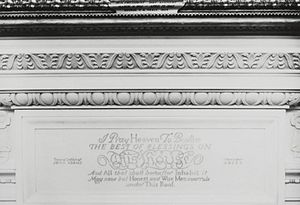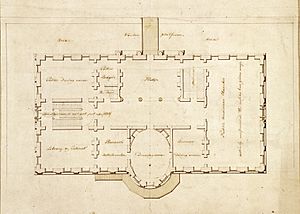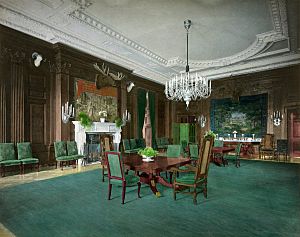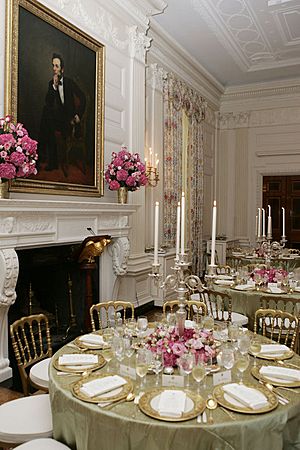State Dining Room of the White House facts for kids
The State Dining Room is one of two dining rooms on the main floor of the White House, which is the home of the president of the United States in Washington, D.C.. It's a big room used for parties, lunches, and important dinners, especially when leaders from other countries visit. The room can seat 140 people and is about 48 feet (14.6 meters) long and 36 feet (11 meters) wide.
This room was originally used as office space. It got its name, the State Dining Room, during the time of President James Monroe, when it was first filled with lots of furniture. Over the years, in the early to mid-1800s, the room was updated many times. Gas lights were installed in 1853. In 1877, new doors were added to the west wall.
A big change happened in 1902. The State Dining Room was made much larger and completely redecorated. It went from looking like a Victorian dining room to a grand hall, complete with stuffed animal heads on the walls and dark oak wood panels. The room stayed this way until the White House was fully rebuilt in 1952.
When the White House was rebuilt in 1952, much of the 1902 design was kept. However, many of the grand furnishings were removed, and the walls were painted a light green color. Another major update happened from 1961 to 1963, making the room look even more like a fancy, old-fashioned style with ideas from different time periods. Small changes were made throughout the 1970s and 1980s, with big updates to the furniture in 1998 and 2015.
Contents
Early History of the Dining Room
The Adams Family's White House
The northern part of what is now the State Dining Room was once part of the Cross Hall, a hallway. There were two sets of stairs leading from the main floor to the second floor. A single, central stair then went up to the third floor (which was an attic back then). The main stairs were not finished when the White House was first used in 1800, but they were likely completed by architect Benjamin Henry Latrobe around 1803. South of the main stairs was a small room that was meant to be a Cabinet Room or the President's Library.

President John Adams was the first president to live in the White House. The house was very large for their needs, and they didn't have much furniture. So, the State Dining Room was temporarily divided to make it useful. The southwest corner became a "levee room" where people could meet the president, while the northwest corner became a dining room.
President Jefferson's Office Space
President Thomas Jefferson used the southwest corner of the State Dining Room as his main office from 1801 to 1809. The room didn't have much furniture then, just a desk and chairs. He even kept his gardening tools and potted plants there! The floor was covered with green-painted canvas. Over time, he added charts, maps, globes, shelves, tables, stools, armchairs, a tall bookcase, and a letterpress printer. For seating, Jefferson moved 12 black-and-gold chairs from the dining room into his office.
How it Became the State Dining Room
Jefferson's successor, James Madison, wanted the room to be a proper dining room. Dolley Madison, the First Lady, worked with architect Benjamin Henry Latrobe to make some changes, mainly closing off two windows on the west wall.
A large dining table, big enough for at least 40 people, was placed in the room, surrounded by simple chairs with woven seats. Silver dishes and a blue-and-gold china set from England were used for meals. A simple "surtout de table" (a long centerpiece) was used in the middle of the table. Besides the dining table, the biggest piece of furniture was a huge sideboard (a long cabinet). The windows had no curtains, and the walls were covered in wallpaper. Paintings of George Washington, John Adams, and Thomas Jefferson were hung on the walls. The Washington painting was a copy of the famous Lansdowne portrait. The canvas floor covering was removed, and a simple carpet was put down. Otherwise, the room still didn't have much furniture.
Rebuilding After the Fire
The White House was burned by the British Army on August 24, 1814, during the War of 1812. The copy of the Lansdowne portrait was saved by two quick-thinking White House staff members who cut it from its frame just minutes before the British arrived.
The White House was rebuilt in 1817. After this, the room that had been the Cabinet Room/Presidential Library was officially called the State Dining Room. The rebuilding added a large fireplace area to the room's west wall.
The State Dining Room was then filled with many new furnishings. President James Monroe, not his wife Elizabeth Monroe (who was not well), was mostly in charge of decorating the White House. Monroe decided to have the walls of the State Dining Room covered in green silk. Two Italian marble fireplaces, with fancy statues on the sides, were also bought by Monroe and installed.
Monroe also bought several fancy gold-colored decorations for the State Dining Room. The "surtout de table," made in France, was 14 feet (4.3 meters) long when fully extended. It had seven sections that could be added or removed to change its length. It had a mirrored bottom and garlands of fruit and flowers around the edge. Seventeen small statues holding candleholders could be placed around the centerpiece. These centerpieces were common in fancy European dining rooms, and Americans were very impressed by this one. Other gold-colored items included pedestals for crystal vases and fancy stands with sphinxes (mythical creatures) holding shallow bowls.
Monroe also ordered the White House's first plates and dishes. This included 72 silver place-settings and many serving dishes. Thirty-six gold-plated silver flatware sets were also bought. A 30-setting gold porcelain china service was purchased, but no pieces have survived. However, some pieces of the matching dessert service, made in Paris, have survived. The dessert plates for this red-on-white china set have a Napoleonic eagle in the center.
Changes in the Mid-1800s
President Andrew Jackson had the dining room wallpapered after 1829. The blue, green, yellow, and white wallpaper with gold stars was used in most rooms on the main floor. Around 1833 and 1834, mirrors, Belgian carpets, and new mahogany dining chairs were added. An 18-light chandelier, originally from the East Room, was moved into the State Dining Room in 1834 for light.
Many visitors to the White House during Jackson's time left the mansion looking worn out. President Martin Van Buren bought a new 30-foot (9.1-meter) table for the State Dining Room and had the chairs covered in blue satin. Blue and yellow drapes and rugs matched the chairs. At some point, the fireplace mantels were replaced with black marble ones, and three chandeliers now lit the room.
Not much upkeep was done during the presidencies of William Henry Harrison and John Tyler due to a national economic downturn. However, President James K. Polk redecorated the State Dining Room in the summer of 1845. New purple and gold drapes were hung, and 42 rosewood chairs with curved legs and heart-shaped backs were purchased. They were covered in purple velvet. The carpet was likely replaced with a Turkish one.
President Franklin Pierce completely updated the room in 1853. The chandeliers were changed to use natural gas, the wood trim was replaced, the room was replastered and repainted, and new carpets and drapes were added. Gold-colored plaster decorations were put around the windows, and new gold frames for the mirrors were added. It's also likely that four walnut side tables were made for Pierce and later used in the State Dining Room.
A large greenhouse was added to the west side of the White House by President Pierce in 1857.
Even though First Lady Mary Todd Lincoln updated most rooms in the White House in 1861, there's not much proof she did a lot to the State Dining Room. However, the room was used by Francis Bicknell Carpenter as an artist's workshop while he painted First Reading of the Emancipation Proclamation of President Lincoln from February to July 1864. In 1867, four walnut console tables were placed against the walls.
Changes in the Late 1800s
The western greenhouse burned down in 1867. In 1869, President Ulysses S. Grant built a larger greenhouse in its place. Grant also rebuilt the main stairs so that only one staircase led to the Second Floor. Later presidents expanded the greenhouse even more. After it was turned into an indoor garden room in 1877 by President Rutherford B. Hayes, new doors were cut through the mansion's stone walls to connect the indoor garden room and the State Dining Room.
Small changes to the furnishings were also made in the late 1800s. In 1880, First Lady Lucy Webb Hayes installed a new carpet and lace curtains. She also bought two fancy Victorian candle holders for $125 each from Tiffany & Co.. These three-tiered items, with flower decorations and small statues at the base, have been in the room ever since.
In 1882, President Chester A. Arthur hired Louis Comfort Tiffany to redecorate the State Dining Room. Most of the work involved painting and making things gold again, including the Monroe "surtout de table." A major redecoration happened again around 1884, with new carpets, curtains, drapes, and wall and ceiling paint. The walls were painted a yellow-brown, with a 5-foot (1.5-meter) high decorated border in shades of yellow and gold.
Electric lights were installed in the room in 1891, including bronze wall lights. By 1901, 40 dining room chairs were moved from the Family Dining Room to the State Dining Room.
1902 Roosevelt Renovation
The White House was greatly updated in 1902 after the West Wing was finished, which allowed many government offices to move out of the main house. President Theodore Roosevelt chose the architectural firm of McKim, Mead & White to manage the updates and redecoration. The old main stairs were removed, and a new Grand Staircase was built east of the Entrance Hall. The State Dining Room was made larger by extending it northward into the space where the old main stairs used to be. The small fireplaces on the east and west walls were removed, and the northern door leading to the indoor garden room was sealed. Where the old indoor garden room door was, a new, huge stone fireplace and mantel (the famous "Buffalo mantel") were added to match the enlarged room's size. McKim, Mead & White designed the room to look like an English manor house, mixing styles like early Elizabethan and Italian Renaissance. Herter Brothers designed and installed new plasterwork on the ceiling and decorative trim. The ceiling was white, and the trim was a light gray. Below the trim was a carved border featuring (at Roosevelt's request) stuffed animal heads. Dark English oak wood panels, carved in a fancy style with flat columns, were also made and installed by Herter Brothers. A white marble baseboard ran around the room, and a new oak floor was put in.
First Lady Edith Roosevelt oversaw the furnishing of the White House, including the State Dining Room. To create the "grand hall" look, tapestries and 11 stuffed animal heads were hung on the wall, and cooking racks were placed over the fireplace. The Monroe fireplaces were moved to the Green Room and Red Room to make way for the "Buffalo mantel."
To furnish the room, Stanford White designed oak armchairs with woven backs and mahogany side chairs. These chairs were made by the A. H. Davenport and Company of Boston. He also designed two small and one large mahogany side tables with marble tops and carved wooden eagle bases. Large, heavy chairs were also used.
A silver-plated chandelier and eight silver-plated wall lights were designed by McKim and installed by Edward F. Caldwell & Co.. The chandelier was unique because it had no glass or crystal. Instead, it had individual candle holders supported by curved pipes. The chandelier was a bit too wide and had to be adjusted. Other needed furnishings came from items already in the room before 1902.
Only a few changes were made to the State Dining Room after the Roosevelt renovation. First Lady Ellen Axson Wilson had the stuffed animal heads removed in March 1913, shortly after moving into the White House. Ellen Wilson passed away in August 1914. President Woodrow Wilson then married Edith Bolling Galt in December 1915. Mrs. Wilson didn't like the two square tables in the State Dining Room and had them replaced with a round table (which could seat 14 to 16 people) that she found in the White House kitchen. Mrs. Wilson also had the drapes replaced and chairs reupholstered.
1952 Truman Reconstruction
The room stayed mostly the same until 1952. One of the few changes was the addition of a painting, Abraham Lincoln by George Peter Alexander Healy, hung over the fireplace by President Franklin D. Roosevelt in 1937. This 1869 painting shows a seated, thoughtful Abraham Lincoln and has been over the State Dining Room fireplace ever since. Roosevelt also added an inscription to the "Buffalo mantel." The inscription was from a letter by John Adams to his wife Abigail written on his second night in the White House: "I pray Heaven to bestow the best of blessings on this House, and all that shall hereafter inhabit it. May none but honest and wise men ever rule under this roof."
The wooden structure inside the White House was failing, so it needed to be rebuilt during the time of President Harry S. Truman. The building was taken apart, and a strong steel frame was built inside the sandstone walls. While this fixed critical problems, much of the original interior was damaged or not put back. The State Dining Room, more than any other room, had most of its wall and ceiling materials reinstalled.
During the 1948-to-1952 rebuilding of the White House, the State Dining Room was completely redecorated. The "Buffalo mantel" was replaced with a simple fireplace design in an old English style, made of dark green marble. The upscale department store, B. Altman and Company, was chosen to help design and supply the new decor and furnishings. Charles T. Haight, the design director, chose new fabrics for the carpet and chairs. The "Buffalo mantel" was given to President Truman (who had it installed in his presidential library). The oak wood panels, which were badly damaged when removed, were reinstalled and painted a bright light green to hide the flaws. King George VI of the United Kingdom donated a carved and gilded mirror frame from the late 1600s and a pair of bronze and blue candle holders from 1770. Edith Wilson's round dining table was removed and replaced with a mahogany dining table in a classic furniture style.
Kennedy Renovation
Jacqueline Kennedy, the First Lady, worked with American antiques expert Henry Francis du Pont and French interior designer Stéphane Boudin on updating the State Dining Room. Both du Pont and Boudin suggested that the changes should bring back the look created by McKim. Many of Boudin's ideas for the room were similar to changes he had made to the dining room at Leeds Castle in England.
Following Boudin's advice, the wood panels were repainted bone white, and the silver-plated chandelier and wall lights were made gold again to match the Monroe-era centerpiece. The wall lights were reinstalled on the side panels. Boudin and du Pont agreed that the 1952 fireplace mantel should be replaced. Boudin designed a new mantel, but du Pont wanted the original 1902 "Buffalo mantel" back and asked the Truman presidential library for it. The library said no, so a copy of the "Buffalo mantel" was made and installed. This new mantel was made of white marble to match the room's new color.
At Boudin's suggestion, McKim's mahogany side and console tables were painted to look like white marble with gold lines, and their eagle supports were gilded. The new colors for these pieces were meant to make them blend in with the panels. A new carpet, a copy of one Boudin designed for Leeds Castle, was made and installed. The "Healy Lincoln" portrait was cleaned and repaired. The old chairs were removed and replaced by the chairs designed by McKim, Mead & White.
The gold patterned drapes installed during the Truman administration stayed until 1967, when new, straight drapes and wavy window decorations were installed. These window treatments were designed by Boudin in 1963, also based on work at Leeds Castle.
A Chinese folding screen was placed in the State Dining Room in 1961. This screen was later given to the White House and eventually moved to the Second Floor. The Monroe administration's "surtout de table," which had been in storage for a long time, was brought back and placed on the table. New gold-plated silver baskets were bought for flower arrangements, and plain tulip-shaped crystal glasses were purchased to add to the existing china service.
The way the State Dining Room was set for events was also changed by the Kennedys. All previous presidents had set the tables in an E-shape or horseshoe arrangement. The Kennedys changed this to round tables, which made for more socializing and less formal rules. Sometimes, tables were also set up in the nearby Blue Room.
Updates by Johnson, Nixon, Reagan, and Bush
In 1967, Lady Bird Johnson oversaw the installation of new drapes, based on a design by Stephane Boudin, and the 1902 chairs were reupholstered. First Lady Pat Nixon worked with White House curator Clement Conger to refresh the room in 1971. She had the room painted an old-looking white in 1971 after the Kennedy-era paint seemed too bright, and she replaced the Kennedy-era carpet with one made in India.
In 1973, two people broke away from a public tour and splashed blood on the walls and some furniture in the State Dining Room. They said they were protesting for oppressed people.
First Lady Nancy Reagan hung new gold silk drapes designed by Ted Graber. She first had the room repainted antique white in 1981, but in 1985, the room was painted off-white with a brownish paint layer.
During the time of President George W. Bush, the worn-out 1952 floor of the State Dining Room was removed. New flooring made of white oak wood was installed in a V-shaped pattern.
Clinton Renovation
By the early 1990s, more than 50,000 people a year were entertained in the State Dining Room. This heavy use left the room looking worn and in need of major repairs.
In December 1998, First Lady Hillary Clinton showed off a newly updated State Dining Room. She was advised by interior designers Kaki Hockersmith and Mark Hampton, and the Committee for the Preservation of the White House. The room's walls were repainted a light stone color, with architectural details lightly highlighted. The pedestal console tables were stripped of their paint that looked like white marble with gold lines, and their original mahogany wood finish was brought back. The gilded chandelier and wall lights were polished and brightened. The room's 66 chairs were reupholstered in a gold patterned fabric. New ivory silk drapes, with printed full-color baskets, flowers, and ribbons, replaced the solid gold fabric drapes from the 1980s. The drapes were designed to match the colors of the White House china. A new 43-by-28-foot (13.1 by 8.5 meter) carpet with a floral pattern was also installed. The cost of the renovation was paid for by the White House Endowment Trust. The Clinton update was not as successful as hoped. The White House Curator noted that at night, without light from outside, the drapes tended to blend into the walls.
The Clintons were also the first to use the East Room for most state dinners, instead of the much smaller State Dining Room. The reason was size: The State Dining Room could only fit about 136 people, while the East Room could seat 260. The Clintons also used large tents, set up on the South Lawn, for state dinners, which allowed seating for up to 700 people. However, President George W. Bush returned to hosting state dinners mostly in the State Dining Room. The gold-upholstered chairs were often removed for meals and replaced with smaller chairs from elsewhere in the White House, as they were too big for many guests around dining tables.
Obama Renovation
By 2011, the heavy use of the State Dining Room had worn out the rugs and drapes.
On June 25, 2015, a newly updated State Dining Room was shown by First Lady Michelle Obama. Mrs. Obama and the Committee for the Preservation of the White House started planning the renovation in 2012. The first part of the renovation, a 28-by-43-foot (8.5 by 13.1 meter) carpet, was installed in 2012. The wool rug has a border of wreaths around a light blue area with clusters of oak leaves. The carpet's design looks like the plaster molding on the ceiling.
The new silk window drapes are light beige, with stripes of bright blue meant to match the blue color of the White House china (which in turn matches the waters of President Obama's home state of Hawaii). The window decorations have heavy swags (curved fabric) with gold fringe, reflecting similar window treatments from the 1800s. The drapes hang from carved and gilded poles whose design is similar to poles in the Red Room and Green Room. The walls and moldings were repainted in different shades of white and glazed to highlight their details.
A new set of 34 mahogany chairs replaced the Theodore Roosevelt-era chairs, which were too large and hard to move. The set includes six armchairs and 28 side chairs. The new chairs were designed to be used for many purposes and fit with both the heavy main dining table and smaller round tables. The look of the Obama armchairs is based on chairs designed in 1818 for President James Monroe. The side chairs are a simpler version of this design. All the chairs are covered in brown horsehair fabric in a grid pattern, with small brass nails. The White House Endowment Trust paid for the $590,000 renovation.
See also
 In Spanish: Sala del Comedor del Estado para niños
In Spanish: Sala del Comedor del Estado para niños





